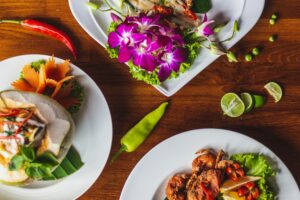Thai Cuisine
Overview of Thai Cuisine
Thai cuisine is renowned for its vibrant flavors, balance of tastes, and use of fresh ingredients. It is deeply rooted in the country’s cultural and historical influences, incorporating elements from neighboring countries and reflecting regional diversity.
Key Characteristics
- Flavor Balance: Thai food emphasizes a harmonious balance of sweet, sour, salty, and spicy flavors.
- Fresh Ingredients: Common ingredients include lemongrass, galangal, kaffir lime leaves, fish sauce, and coconut milk.
- Herbs and Spices: A wide variety of herbs and spices are used to create complex flavors.
Popular Dishes
- Tom Yum Goong (Spicy Shrimp Soup): A hot and sour soup with shrimp, flavored with lemongrass, kaffir lime leaves, and galangal.
- Pad Thai: Stir-fried noodles with tofu, shrimp, peanuts, and bean sprouts.
- Green Curry (Gaeng Keow Wan): A coconut milk-based curry with green curry paste, chicken, and Thai eggplants.
- Som Tum (Green Papaya Salad): A spicy salad made from shredded green papaya, tomatoes, peanuts, and chili.
- Massaman Curry: A rich, mildly spicy curry with potatoes, peanuts, and meat (often beef or chicken).
Regional Variations
- Northern Thai Cuisine: Influenced by Burmese cuisine, featuring dishes like Khao Soi (coconut curry noodle soup) and Sai Oua (herbal sausage).
- Northeastern Thai Cuisine (Isan): Known for its bold, spicy flavors and dishes like Larb (minced meat salad) and Sticky Rice.
- Central Thai Cuisine: Characterized by the use of coconut milk and palm sugar, with dishes like Tom Kha Gai (coconut chicken soup) and various stir-fries.
- Southern Thai Cuisine: Heavily influenced by Malay cuisine, known for its spicy curries and seafood dishes, such as Gaeng Tai Pla (fish kidney curry) and Kua Kling (dry-fried curry).
Influence of History and Culture
Thai cuisine reflects the country’s history of trade and interaction with other cultures. Chinese immigrants introduced techniques like stir-frying and noodle-making. Indian and Malay influences are evident in curries and spices. The use of fresh herbs and aromatic ingredients is a testament to Thailand’s agricultural heritage and tropical climate.
Conclusion
Thai cuisine is a delightful blend of flavors, ingredients, and cooking techniques that create a diverse and harmonious culinary tradition. Its emphasis on fresh, bold, and balanced flavors makes it a beloved cuisine worldwide.
Thai Cookbooks
- Simply Thai : The Ultimate Thai Cookbook That Teaches You How to Cook 30 Delicious Thai Food Dishes!
- Thai Cookbook : Extremely Easy Chicken, Beef, Seafood, Lamb and Vegetable Recipes
- Modern Thai Food : 100 Fabulous Thai Recipes for Contemporary Cooks (a Thai Cookbook)


